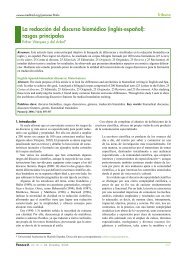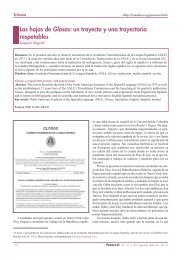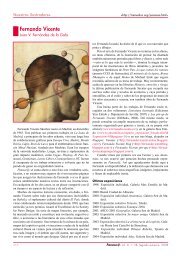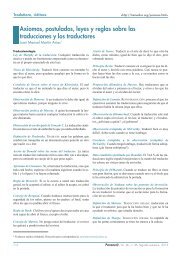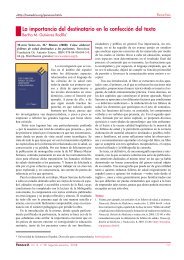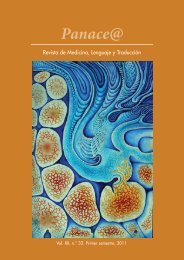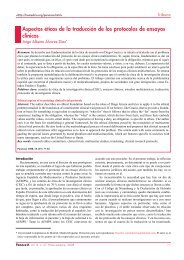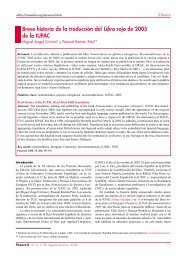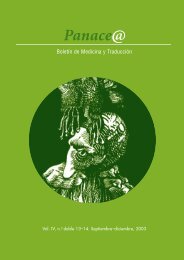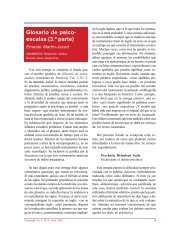Phraseological units: Their instantial use and interpretation
Phraseological units: Their instantial use and interpretation
Phraseological units: Their instantial use and interpretation
Create successful ePaper yourself
Turn your PDF publications into a flip-book with our unique Google optimized e-Paper software.
Reseñas<strong>units</strong> in the past. To know about these different meanings<strong>and</strong> the process of change that has brought about thepresent meaning of the phraseological unit is crucialwhen we want to underst<strong>and</strong> older texts, particularlywhen phraseological <strong>units</strong> are only alluded to or onlypartially quoted.3. Theory vs. practice. Since phraseological <strong>units</strong> are usuallyalluded to or <strong>use</strong>d according to their <strong>instantial</strong> <strong>use</strong><strong>and</strong> not according to their core form, theoretical studiescan fail if they are not built on case studies of actual <strong>and</strong>practical <strong>use</strong>s, mainly in literary texts.4. Literary <strong>use</strong> vs. common <strong>use</strong>. As has been pointed out already,research into the <strong>use</strong>s of phraseological <strong>units</strong> in literarytexts is essential. Only then can they be contrastedwith their utilization in common language.5. English vs. other languages. <strong>Phraseological</strong> <strong>units</strong> changediachronically <strong>and</strong> instantaneously within a single language,but they also change when they are transferredbetween languages. 2 Knowing about these changes <strong>and</strong>about the different forms that phraseological <strong>units</strong> cantake is especially important when trying to translate betweenlanguages (see pp. 199-211).6. Literal meaning(s) vs. figurative meaning(s). <strong>Phraseological</strong><strong>units</strong> are typical cases of sentences having both aliteral <strong>and</strong> a figurative meaning, where the figurativemeaning is its salient <strong>and</strong> first order meaning. Nevertheless,since the original literal meaning motivates thecommon figurative meaning(s) <strong>and</strong> speakers might beaware of this original literal meaning, <strong>instantial</strong> <strong>use</strong>s <strong>and</strong>changes can achieve certain cognitive effects, word plays,<strong>and</strong> allusions. This phenomenon is commonly exploitedin advertising, marketing, <strong>and</strong> jokes (Nerlich & ChamizoDomínguez, 1999; Nerlich & Clarke, 2001), * as AnitaNaciscione stresses in several places <strong>and</strong> by means ofvarious examples, where the cognitive <strong>and</strong> communicativeeffect is achieved beca<strong>use</strong> hearers “read” both theliteral <strong>and</strong> the figurative meaning.What the book suggestsAnita Naciscione’s book is interesting <strong>and</strong> <strong>use</strong>ful not onlybeca<strong>use</strong> of what it explicitly says, teaches, <strong>and</strong> shows, butalso beca<strong>use</strong> it is also suggestive of new ideas. We will thereforefollow some of the leads suggested by this book.We previously alluded to the fact that Anita Naciscionealways documents the actual <strong>use</strong> of phraseological <strong>units</strong> inan English literary texts, quoting examples from Chaucer(<strong>and</strong> sometimes before) to Tolkien (p. 86), showing howwriters exploit phraseological <strong>units</strong> which they find in <strong>use</strong> inordinary language. So when Shakespeare alludes to “a cathaving nine lives,” 3 it is clear that the proverb was already in<strong>use</strong> at the time of Shakespeare, but it can be found in otherwriters who wrote before Shakespeare. All these writers <strong>instantial</strong>lyexploit phraseological <strong>units</strong> they find in common* Bibliographical references are given in parentheses; the numbersthat appear in square brackets refer to specific examples of text.language. But a writer can also create a phraseological unit,sometimes despite him/herself, which then enters commonlanguage <strong>use</strong>.But the literary tradition of a language <strong>and</strong> culture goesbeyond “literature” strictly speaking. We mean that a literarytradition also includes philosophical texts, scientific texts,etc., <strong>and</strong> current phraseological <strong>units</strong> can also originate inthese types of text. Take the following two examples ofphraseological <strong>units</strong> which, when <strong>use</strong>d, have certain philosophicalimplicatures. The first one, [1] “Le bon sens est lachose du monde la mieux partagée” (Descartes, 1973: 1), 4derives from previous philosophical tradition. By contrast,the second one, [2] “Homo homini lupus” (Hobbes), derivesfrom literary tradition but has conventional philosophical implicatureswhen it is <strong>instantial</strong>ly <strong>use</strong>d.[1] is the well-known opening phrase of Descartes’ Discourseon Method, <strong>and</strong> has become a well-known phraseologicalunit widely quoted or alluded to, at least amongphilosophers. 5 In fact, Descartes’ sentence is commonly regardedas the manifesto of rationalism <strong>and</strong> the “Magna Carta”for the freedom of thought. 6 Now, Descartes’ sentence isitself an allusion to an <strong>instantial</strong> <strong>use</strong> of another sentence fromMichel de Montaigne’s Essais: [3] “On dit communémentque le plus juste partage que nature nous aye fait de sesgraces, c’est celui du sens” (Montaigne, 1962: 641). 7Descartes alludes to Montaigne to stress that, although bothshare the same starting point for their philosophising, he(Descartes) strongly disagrees with the rest of Montaigne’sphilosophy, as one can see when reading the subsequentpages of the Discourse on Method. 8[2] is a clear case of a philosophical sentence, which hasits origin in a literary work, <strong>and</strong> which has been <strong>instantial</strong>lychanged in order to put forward a general thesis about the natureof the human race. It is commonly assumed <strong>and</strong> believedthat Thomas Hobbes minted [2] in order to summarize histhoughts about human nature, <strong>and</strong> this is (partially) true. Certainly,that sentence was created by Hobbes in the sense <strong>and</strong>meaning with which it is usually quoted, 9 but it is also truethat [2] is an <strong>instantial</strong> <strong>use</strong> of a sentence that can be found inPlautus (1976: 112): [4] “Lupus est homo homini, non homo,quom qualis sit non novit.” Now, what Plautus said about arestricted, particular case was generalized by Hobbes in orderto refer to the whole of the human race. Subsequently Plautus’s<strong>use</strong> of this phrase was forgotten <strong>and</strong> Hobbes’ <strong>use</strong> of thephrase <strong>and</strong> its meaning became established as a proverb <strong>and</strong>as a résumé of a philosophical theory about the human race.In the previous paragraph we alluded to phraseological<strong>units</strong> which have been <strong>instantial</strong>ly <strong>and</strong> consciously changed.However, it is also interesting to reflect on cases in whichphraseological <strong>units</strong> have been unconsciously (or erroneously)changed, but which have entered common <strong>use</strong> in spite ofthis error (or perhaps thanks to this erroneous quotation). Togive one example: the well-known Spanish phraseologicalunit [5] “Estar en el c<strong>and</strong>elero” (to be at the top, to be popular;literally “To be on top of the c<strong>and</strong>lestick”) is usually <strong>and</strong>jocularly quoted as [6] “Estar en el c<strong>and</strong>elabro” (literally “tobe on top of the c<strong>and</strong>elabrum”) since a famous Spanish ac-Panace@ Vol. IV, n.º 12. Junio, 2003206



